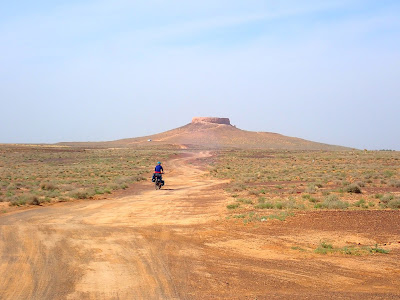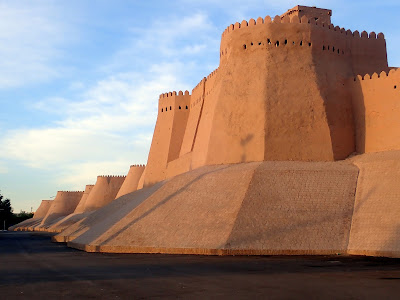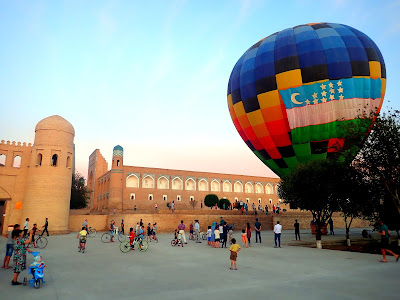May 2018
Morning came, and we had another early start to beat the heat. The desert on this side of Nukus was different than what we had been riding in so far; small rolling hills, sandy and full of scrubby bushes. The landscape was tinged with orange and reminded me of the colours around Monument Valley in Arizona. Around mid-morning we turned off the highway and followed a sandy track out into the desert, heading towards a rocky outcrop that stood solitary against the sky. After a few kilometres we came to the Chilpik Tower of Silence. It’s thought to be the earliest example of the Zoroastrian funeral rituals. The Zoroastrians believed that demons would contaminate the bodies of the dead, so they used to place the deceased on top of this alter for purification. Once the bones had been picked at by the birds and cleansed by the elements, the skeletons were removed and placed elsewhere. After a short hike up and a squeeze through the rocky outer wall, we were on top of the Tower. Standing up high, with birds of prey still circling overhead, it’s easy to picture the old rituals. In later years this place was used for defence. With an unimpeded, 360 degree view of the surrounding desert, I can see why.
After our quick tourist stop we pedaled into the small town of Mangit, where we found a big sprawling market where we could restock. I took first shift watching the bikes while the others went shopping. Almost immediately I was surrounded by drunk men, asking me questions, pawing at the bikes, laughing at each other. They were harmless, but it was pretty intense. Eventually the others came back and we were trying to pack up to leave, still surrounded by the mob of men. There were lots of them. It was hot, we felt vulnerable and uncomfortable and were trying to escape. One younger guy who spoke a bit of English came over; I think he could see our discomfort. “You are very interesting to these people”, he said. It seemed like he was saying that not much unusual happens there, we were a novelty and they were curious. I felt bad for wanting to run away.
After finally escaping, we carried on towards Khiva, through endless farmland and cotton fields. That evening we met a very friendly woman who invited us to camp next to her field. We had a really nice talk with her and a few other workers. Throughout the night we had more visitors, as people kept stopping by to say hello and bring us food and beer. Steve and I are so used to camping away from people that sometimes we forget how nice it is to connect a bit more with the people who live in the places we are passing through. Even after being back home, one of my best memories of Uzbekistan is how warm, open, and kind the people were.
The next day we reached Khiva, tired and grumpy after a day of bumpy roads and duststorms. We rested here for a few days and explored the old walled city. Khiva was an important Silk Road stop that was best known for its slave trading. It’s a pretty neat place and feels very old, with its high mud walls and blue-tiled mosaics. Our stay was relaxing and mostly uneventful, except for when I discovered that apricot seeds are poisonous as I was shoveling handfuls of them into my mouth. I spent a few hours convinced I was about to die, but (spoiler alert!) I didn’t.
The next stretch, between Khiva and Buchara, was hard. Temperatures just kept climbing, with every day above 40C. So much of what I remember of this stretch is just heat. And sand. And sun. And hours and hours of melting and burning. I remember sand blasting across the road and into our faces. At one point Steve and I filmed a video to our future selves, to remind us why desert cycling is terrible and why we should never do it again. In the video you can barely hear our words over the wind, and a transport truck hurtles by, covering us with sand and knocking my bike over. We adopted a little motivational phrase, courtesy of another cyclist’s blog we had been following. (His blog is at bryanmkevan.bike). We hadn’t met him, but he was about a month ahead of us on the same route, and had written the following in response to the constant questions of why one would choose to do this:
“The answer is supposed to be ‘because I like it’, right? The conviction has been lacking behind those words in recent weeks. Over tea and kebabs in Aktau I said it with a smirk and an abundance of swagger. 100km outside Buchara I screamed it through tears into a suffocating desert headwind.”
And so it became our mantra; “Because I like it!” We’d yell it at each other through the wind, half laughing and half crying, a hint of madness in our eyes from the absurdity that is riding a bike through the desert on purpose. Bryan, if you ever stumble across our blog, thanks for that line. We really appreciated it.
Once again, the best parts were the camping. Huge open skies filled with stars, the chattering of all sorts of desert insects, and sometimes even sheep bells or camels off in the distance. Nothing feels better than sitting in the sand eating noodles after a day of suffering. I think that’s what makes us keep going; keep putting ourselves in these ridiculous situations. For all the misery, the in between times are really something special. The times where you’re destroyed, physically, but you take a moment to really appreciate all the effort, time, planning, and persistence that has brought you this far. And all that has led you to sitting in the sand with your friends, in the middle of a desert, somewhere in Uzbekistan. I also had my 35th birthday along this stretch, which probably made me feel a bit more introspective. Karen and Jamie presented me with a bottle of Uzbek Cognac that they had hidden in their panniers from Khiva. We passed it around and I felt pretty good about the life decisions that had led me to this point.
Another piece I remember from this stretch is a whole host of interesting characters. One day we came across an Uzbek guy, traveling his home country by bike. His bike was nothing special and he had a big bulky quilted sleeping bag strapped precariously to the back of it. He was stoked and loving life. We had a quick chat before he threw us a thumbs up and pedaled off towards Khiva. Then there was the Dutch tour bus that waved us over and stuffed us full of cheese and Coke while peppering us with questions. There was an older Austrian couple in a big badass off-road rig heading towards the Pamirs, and a young German couple in a SUV who had been on the road for over a year. On the way into Buchara we met a gang of Europeans on motorbikes and made the mistake of asking them how long they’d been traveling for. Two weeks, they said. Two weeks from Switzerland to Buchara. How long had it taken us to do the same? We don’t ask those questions anymore if there’s a motor involved.
Finally, destroyed again, we rode into Buchara for another few days of resting and resupply. While there we explored the city and took in some of the tourist sights. Yet another important stop along the ancient Silk road, the city is full of old mosques, madrasas, and caravanserais, many of them very well preserved. One of my favourite structures was the Kalyan Minaret, 48 metres tall and built in 1127. The legend says that when Genghis Khan arrived in Buchara, he tilted his head back so far to see the top of it that his hat fell off. He admired the audacity of the tower to do such a thing, and ordered his army to spare it as they destroyed the rest of the city. Over the years the tower was used as a lookout, as well as for public executions. As recently as 1920, people were thrown from the top of the tower to the ground below, which is how it earned its nickname “Tower of Death”.
Our mornings were usually spent wandering around the markets and bazaars, which were busy and sprawling and filled with all the sights and smells you would expect from an old desert city like Buchara. We stocked up on dried fruits and treats, and gorged on tasty street food. Our afternoons were spent hiding from the heat in our guesthouse, trying to rest and plan for the next section of riding.
We decided that our little band of four would split up again, now that the most remote parts of the desert were over. Karen and Jamie wanted to see Samarkand, whereas Steve and I were keen to take a different road that would get us into the mountains a few days sooner. So we said our goodbyes and made plans to reunite in Dushanbe, about a week away.
After Buchara, we had another 2 days of desert before the terrain started changing. Almost imperceptible at first, the flat ground gave way to hills and sandy mountains. The road wound through big ravines and ridges that looked like petrified sand dunes. Villages and towns were tucked into the folds and perched on the knolls. We started climbing and went through two mountain passes, hitting our high point in Uzbekistan at 1498m. It was such a nice change in scenery, and so nice to see a different side of this country that isn’t just desert.
Despite getting a bit higher, the heat was still oppressive. It was even hotter than the last stretch, as if that was possible. We were hitting the road as the sun was coming up, but even that just postponed the inevitable. By early morning it was still pushing 40C. Every afternoon was above 45C. On our hottest day, the bike computer read 52C mid-afternoon. Sweat would ooze from all my pores and run in little rivers down my back. My shirt was crusted with salt. My face felt like I was crying, but it was just sweat pouring down my cheeks. I’m not even exaggerating when I say that we barely made it, with shade breaks at every opportunity and each drinking 4 litres of water per day.
I was starting to feel pretty tired, a deep fatigue from so many hot endless days. We were running out of sunblock and hadn’t been able to find more. The last month had been so hard. We were exhausted from the heat, the language barriers, the limited supplies, always being on the move and having to plan every step. We were beginning to feel pretty travel-weary, and the same feelings of burnout from earlier in the trip were starting to resurface. This time though, we had an end in sight. We were days from Tajikistan, and the Pamir highway that promised to be a highlight of the trip. So we kept riding. Five days after leaving Buchara we reached the border town of Denov, which was one of the busiest, most chaotic places we’d seen in months. With all the traffic, noise, and black market money changers trying to get your cash, it was the most intense border town of the entire trip. It was almost a welcome chaos after all the isolation, and we changed our money and cruised through it all with the confidence that comes after almost 8 months on the road and 18 border crossings in that time. Uzbekistan collected our registration slips and stamped us out, and Tajikistan stamped us in. We were now officially out of the desert and into country #19. The mountains were close now, and we were ready.
Uzbekistan Round-Up:
ODO start: 8800 km
ODO finish: 10 384 km
Total distance: 1584 km
Actual Country name: O’zbekiston Respublikasi
Days in Country: 22
Nights camped: 12
Highest temperature: 52.8C (as recorded on the bike computer)
Flat tires: 3 (All Elaine. Steve changed my 2 birthday flats.)
Crashes: 0
Birthdays: 1
Other cyclists met on the road: - A Swiss girl, riding from Tashkent back to Europe
- A Uzbek guy, riding from Tashkent to Khiva
Fun Country fact: Uzbekistan is one of only 2 doubly landlocked countries. (The other is Liechtenstein)

















No comments:
Post a Comment